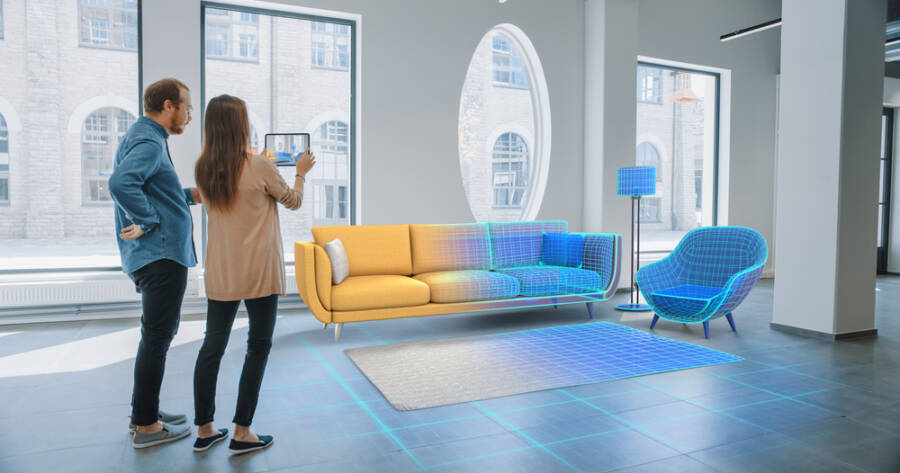Augmented Reality (AR) has long been associated with gaming, transforming how users interact with digital landscapes in games like Pokémon GO and others. However, AR technology extends far beyond gaming, offering innovative solutions across various industries by overlaying digital information on the real world. This potent mix of reality and digital enhancements allows businesses to redefine user experiences, efficiency, and engagement. Learn how AR is making transformative impacts across diverse sectors, paving the way for practical applications beyond entertainment.
Revolutionizing Retail Experience
In the retail industry, AR is being used to create personalized and enhanced shopping experiences.
Virtual Try-Ons and Showrooms
Retailers like IKEA and Sephora leverage AR to allow customers to visualize products in their spaces or virtually try on cosmetics and fashion items. By using AR-powered apps, consumers can see how furniture fits within their homes or experiment with makeup shades without physically testing products. This technology not only aids decision-making but might also reduce return rates and enhance customer satisfaction.
Interactive Marketing and Advertising
AR opens new avenues for interactive marketing by enabling brands to engage consumers through immersive ads and experiences. Campaigns utilizing AR can provide interactive story-driven content that captivates audiences. When users engage through AR-enabled ads, brands can offer interactive experiences that may lead to deeper consumer connections and higher retention rates.
Enhancing Education and Training
Educational institutions and companies are adopting AR to transform learning and training methodologies.
Immersive Learning Experiences
AR can make educational content more engaging and interactive. Textbooks and classroom materials that incorporate AR elements bring static content to life, allowing students to visualize complex information in 3D. For example, biology students might explore anatomical models in detail, providing a richer and more effective learning experience.
Corporate Training Solutions
In corporate environments, AR is increasingly employed for training purposes, particularly in fields requiring hands-on practice. AR can simulate tasks in a risk-free virtual setting, helping workers practice skills without real-world consequences. Industries such as medicine, aviation, and engineering use AR-based training modules to provide safer and more comprehensive experiential learning.
Transforming Healthcare Delivery
AR technology is making significant contributions to healthcare, offering innovative approaches to diagnostics and patient care.
Surgical Precision and Visualization
In surgeries, AR can provide surgeons with real-time data and enhanced visualization overlaid onto their field of view, potentially improving precision and outcomes. By integrating data from various imaging sources, surgical teams might better plan and execute procedures, enhancing the accuracy of minimally invasive surgeries.
Patient Education and Engagement
AR also plays a role in enhancing patient education by visualizing treatment plans and procedures. Patients can engage with interactive AR content to better understand their health conditions or the surgical procedure they may undergo. Improved understanding and engagement might result in better patient satisfaction and adherence to treatment plans.
Improving Navigation and Real Estate
Navigation and real estate sectors are utilizing AR to offer improved user experiences and innovative solutions.
AR Navigation Systems
AR-powered navigation apps are enhancing the way people traverse environments by overlaying digital directions in the real world. These systems can guide users via real-time visuals and cues directly on their screens, whether finding a specific location within a complex building or navigating outdoor spaces. This technology could improve accessibility and convenience in unfamiliar settings.
Real Estate Visualization
Prospective buyers and renters use AR to visualize properties and their potential customizations. Real estate platforms employing AR technology allow clients to explore homes remotely and modify layouts or decor virtually. This immersive experience enhances understanding of a space’s possibilities and can facilitate more informed decision-making without physical visits.
Bridging Gaps in Manufacturing and Maintenance
In the industrial sector, AR enhances efficiency and accuracy in manufacturing and equipment maintenance.
Assembly Line Optimization
AR can guide workers through complex assembly tasks, reducing errors and training time. By providing step-by-step instructions digitally overlaid onto physical components, workers can efficiently follow processes with fewer interruptions and increased accuracy. AR aids in streamlining operations, decreasing the need for extensive manuals and boosting productivity.
Equipment Maintenance and Troubleshooting
AR-powered maintenance solutions provide technicians with critical information as they perform equipment repairs. Guidelines and real-time diagnostics can be displayed within the field of view, offering insights and solutions. This integration could result in faster issue resolution, reduced downtime, and optimized maintenance processes.
Learn More Today!
Augmented Reality is poised to transcend its gaming origins, influencing a wide array of industries with transformational applications that enhance functionality and user experiences. Through innovations in retail, education, healthcare, navigation, real estate, and manufacturing, AR is redefining the boundaries of technology in everyday life. These applications not only offer practical benefits but also represent a shift towards more interactive and engaging user experiences across various domains.
As AR technology matures and becomes more accessible, its potential to bridge the physical-digital divide will result in increasingly sophisticated and far-reaching applications that augment reality in exciting and meaningful ways. Embracing AR’s potential could lead to profound changes in how industries operate and engage with their audiences, heralding an integrated future where the digital and physical worlds seamlessly coexist.

